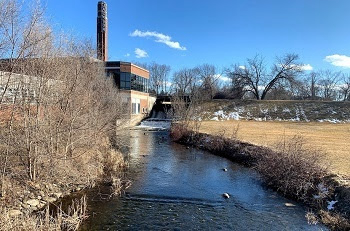Reef Restoration at Grand Traverse Bay, MI

During the last two years, a major cooperative project has placed more than 600 tons of rock in the East Arm of Grand Traverse Bay to rehabilitate a degraded reef to increase spawning habitat for several native fish species.
The partners in this effort, the Michigan Department of Natural Resources, The Nature Conservancy, Central Michigan University and the U.S. Fish and Wildlife Service, added 200 tons of that rock during the week of Aug. 1 to implement phase two of this large-scale rehabilitation project.
The rocky shoreline in the East Arm of Grand Traverse Bay near Elk Rapids has extraordinary habitat for a dozen native fish to use for spawning purposes – including rock bass, smallmouth bass, round and lake whitefish, lake trout and cisco (lake herring). While the majority of the spawning habitat at the Elk Rapids reef is in excellent condition, one particular area was degraded by a shipping dock built more than 130 years ago for the iron ore industry.
“Despite the degraded condition of this part of this reef, native lake trout, whitefish and cisco were still spawning on that area, but our surveys have indicated none of their eggs survive to hatch,” said Randy Claramunt, a DNR fisheries research biologist. “This collective rehabilitation project should reverse that trend.”
Rehabilitating the reef will provide the nooks and crannies native fish need to lay their eggs and to keep them safe throughout the harsh winter conditions until they hatch in spring, which hopefully will increase population numbers, especially for cisco.
In the past, degraded habitat, overfishing and aquatic invasive species caused cisco numbers in Lake Michigan to plummet in the late 1950s. Today, only a few small populations remain, and one of them spawns at the Elk Rapids reef complex. This reef rehabilitation project represents a unique opportunity to increase a key cisco spawning population.
Last year, biologists from the DNR, The Nature Conservancy and Central Michigan University worked together to lower approximately 450 tons of specially selected rocks on the degraded habitat for phase one of the reef restoration. With phase two now complete, the team will monitor the site and evaluate the project to see how many eggs are deposited during the fall spawning season, how many of them survive, and how many adults return to spawn at the reef each year.
“Lessons learned from this project will inform future habitat rehabilitation efforts in the Great Lakes and help us better understand how to do this valuable work,” said Claramunt.
A brief video documenting the recent work is available on YouTube: https://youtu.be/KORY5z5Vai8.






